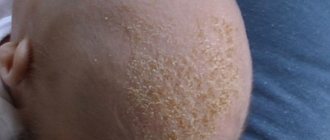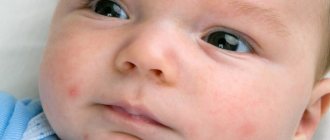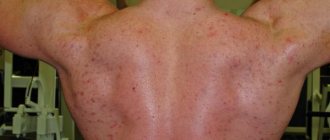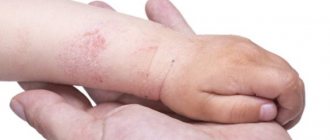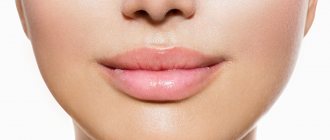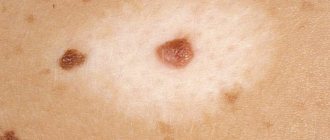In infants and newborns, there are features of the structure and development of the skin, characterized by such properties as:
- accelerated blood circulation;
- superficial location of blood vessels;
- immaturity of sweat and sebaceous ducts;
- high skin hydration.
Miliaria is a nonspecific skin disease that occurs as a result of disruption of the sweat glands or improper care of the body surface. That is, this disease does not have a viral or bacterial source. And a red rash occurs on certain parts of the body only due to certain characteristics of the baby’s body.
Let's consider the first manifestations of skin ailment in order to determine the differences between prickly heat and other serious diseases that can provoke the development of severe and dangerous acute infections.
Classification
There are several types of prickly heat:
- Red - individual nodules and blisters are surrounded by reddened skin, but do not merge. It most often occurs in skin folds - in the groin, armpits, and neck. The rash bothers the baby with severe itching and pain on contact. Usually an annoyance for one to two weeks.
- Crystalline - small silver or white bubbles appear on the baby’s torso, face, and neck. Merging, they form quite large spots and burst easily, leaving flaky areas in their place. The rash does not torment the baby with itching or pain and dries out after two to three days.
- Papular - appears a few hours after the baby sweats. Small flesh-colored bubbles appear on the dry skin of the limbs and torso and, after some time, disappear without a trace.
Other types, white and yellow, are complicated forms.
Causes of prickly heat
Miliaria occurs when several factors combine: overheating, excessive sweating, blockage of sweat ducts. The tubules and orifices (the places where they come to the surface) cannot cope with the increased load and become clogged with skin cells.
When does a child overheat?
- wearing clothes that are too warm, especially synthetic ones
- wearing disposable diapers for a long time in hot weather or in a hot room
- prolonged exposure to a hot, stuffy, humid room
- rare swimming and air baths
- poor hygienic care for the baby, the use of greasy, poorly absorbed creams that reduce natural heat transfer and impair skin respiration
- during illness (ARVI, sore throat in a child, chickenpox, measles, etc.) in the presence of high temperature
Sometimes the cause of prickly heat can be an allergy to the material of the diaper or simply its small size.
Constant prickly heat can be one of the symptoms of rickets.
If friction, feces, and urine are added to overheating, then prickly heat quickly turns into diaper rash, and diaper rash is already an inflammation of the skin, but without the addition of an infection.
If you continue to “soar” the child in diapers, rarely change them, do not take care of the baby’s hygiene, and at the same time keep him in a hot room and dress him too warmly, diaper rash can develop into a more serious problem - diaper dermatitis, which occurs with the addition of an infection .
But even with sufficient care and slight overheating, there are children whose mothers should be especially concerned about preventing prickly heat, even if the child is already 2 years old, as it quickly turns into diaper rash and dermatitis:
- children with allergies;
- overweight children
- children suffering from endocrine diseases and metabolic disorders (diabetes mellitus, obesity, rickets, see symptoms of rickets in a child)
- children suffering from seborrheic dermatitis, a tendency to diarrhea
- artificial children
- premature babies
Doctor Komarovsky's opinion
Evgeniy Komarovsky warns that a rash is not a cause, but a consequence, so first of all it is necessary to establish what caused it. Factors in the appearance of skin rashes can be diathesis, mechanical damage, various infections, allergies and even a reaction to blood clotting. First, you should try to determine whether the rash is dangerous or not, and then look for its culprit. If there are no signs of infectious diseases, the baby is cheerful and active, and of all the symptoms there is only a rash - the cause may be allergies, prickly heat or insect bites. Mommy will have to remember the previous day and try to figure out what could have caused the baby to get sick - buying new clothes, eating an orange, or being bitten by small insects.
Doctor Komarovsky warns! If the rash on the child’s skin has elements of hemorrhage, and the baby is vomiting, call an ambulance immediately!
The beloved doctor states that with the onset of heat, the appearance of prickly heat is not at all uncommon. A cluster of small pimples surrounded by reddened skin most often appears on the neck, gradually spreading to the face, back and chest, and behind the ears. Dr. Komarovsky advises diluting a teaspoon of soda in a glass of water and wiping the affected areas with a cotton ball soaked in the solution, lightly patting it several times a day. You can also use simple starch, using it instead of powder, but the main thing is to keep the baby undressed as often as possible in the heat. Let your baby take a break from diapers and tight clothes, and let his skin enjoy the touch of cool air.
What does prickly heat look like in children - photo
Symptoms of prickly heat appear as a result of blockage of the excretory ducts of the baby's glands. In children, they always manifest themselves in the same way: some areas of the baby’s skin become covered with a small red rash, which often has a clear liquid inside, as in the photo. A child, regardless of whether he is one month old or one year old, is susceptible to prickly heat. A profuse rash in children appears on the surface of the least ventilated areas of the skin.
Types of the disease depending on the area of skin damage:
- prickly heat on the face - localized in this area quite rarely, but often this occurs in situations where the rash moves from the head to the neck or vice versa;
- scalp – blisters often appear on the temples and forehead;
- The neck is one of the most common places for nodules to appear. This is due to the fact that it has relatively fixed folds and is often subject to sweat;
- The back is the main reason for the appearance of excessively warm or poor-quality clothing. It is noteworthy that the pathology involves the upper back;
- groin and butt – occurs due to wearing tight diapers and insufficient hygiene of intimate places;
- prickly heat on a child’s head – formed due to wearing a hat in the warm season;
- on the chest and abdomen - such areas of the baby’s body are rarely affected by prickly heat;
- prickly heat on the hands and feet - often localized in the folds, namely on the hands, on the inside and outside of the elbows and knees, on the feet and in the armpits.
It is noteworthy that in the vast majority of cases, prickly heat-type rashes cover the baby’s entire body.
Treatment of heat rash
The development of prickly heat in children is not a pathological phenomenon and does not require specific treatment. At the initial stage of development, it is enough to monitor the baby’s hygiene and prevent scratching of the rash and infection of the wounds.
It is important to eliminate from the baby’s life factors that provoke sweating and waterlogging of the skin. Treatment may vary depending on the cause of heat rash. If the problem arose as a result of underdeveloped sweat glands, then thanks to care, the pimples will disappear in a couple of days.
If acne has formed as a result of a disease accompanied by hyperthermia, then treatment should be aimed at eliminating the pathology.
To eliminate a rash on the head that does not go away on its own and causes discomfort to the baby, you can use folk remedies while bathing the baby:
- chamomile infusion;
- decoction of calendula;
- infusion of oak bark, bay leaf;
- baking soda solution;
- salicylic alcohol;
- iodine;
- manganese solution;
- decoction of string.
You can also cope with prickly heat in infants with the help of certain medications. One of the effective and affordable medicines for rashes on the head is zinc ointment, which relieves inflammation and dries out the skin. The ointment can only be used on dry, well-cleansed skin.
In addition to zinc ointment, ointments can be used to treat prickly heat:
- Bepanten;
- Sudocrem;
- La Cree;
- Zenerite;
- Desitin.
The ointments contain vitamin B5, which accelerates the healing of the skin. If regular use of creams for several days does not bring results, then you should visit a pediatrician.
How to distinguish miliaria from other types of rash?
Miliaria in children appears in the form of skin redness and rash, but it is often confused with urticaria, diathesis, lichen, dermatitis, measles or allergies. Sometimes it is very difficult to distinguish it from other diseases, even from a photo, so to get an accurate diagnosis it is better to consult a doctor and get tested.
Usually, prickly heat begins with the formation of small pink dots on the skin, and then turns red and increases in size, bubbles with a clear liquid appear inside, and when they burst, the skin begins to peel off, and prickly heat can also be identified by the baby’s constantly weeping skin.
If a child tries to scratch the rash, but following the rules of hygiene does not produce results, then this is a clear signal that the baby has some other disease.
Types of miliaria
Doctors classify miliaria into four main types. Characteristic for everyone:
- rash on the epidermis in the most sensitive places;
- growth in size;
- causing discomfort in the baby.
Important: any type must be treated promptly.
Crystalline
In 75% of cases, the crystalline form is diagnosed from 1.5 to 5 months of the child’s life.
Characteristic:
- white rash;
- in the form of tiny bubbles with liquid;
A clear liquid subsequently emerges from the bubbles.
- rashes are mainly observed on the face and buttocks, as well as in the armpits.
Let's celebrate! The crystalline form does not require drug treatment (if the form is not advanced), but requires the implementation of proper standards for caring for the newborn.
Red
The red type is most often diagnosed before 7–8 months of a child’s life.
Characteristic:
- the formation of a tiny rash on the skin, accompanied by extensive redness of the epidermis;
- 2–3 days after the rash appears, itching begins;
- restless state of the child.
Note: in 70% of cases the baby experiences constant itching.
Papular
This type occurs if the room is excessively hot or has high humidity.
Characteristic:
- the appearance of tiny blisters on the skin;
Their size is 1 – 1.5 millimeters.
- Mostly such rashes are observed on the arms, legs and abdomen;
- skin peeling and itching are noted.
Important: it is impossible to completely cure this type if the maintained temperature in the room is not changed.
Deep
The most severe form of prickly heat is deep. Characteristic:
- the formation of the rash occurs in the deep layers;
- the average size of pimples is 2 – 3 millimeters;
- the main places of localization are the groin and back;
- there is a strong burning sensation.
Important: deep-type treatment is selected only by pediatricians.
Complications
Complications of prickly heat include diaper rash, diaper dermatitis and infection of microtraumas that occur when a child scratches the skin.
The addition of a secondary infection is manifested by a number of new symptoms:
- increased body temperature;
- itching of the skin and anxiety of the child (if they did not exist before);
- the liquid in the bubbles becomes cloudy and turns yellow or white;
- the bubbles quickly open, and wet crusts appear in their place.
And if you can cope with ordinary prickly heat on your own, then if such signs appear, you should urgently consult a doctor.
Effective remedies
To quickly get rid of heat rash, you should pay attention to the following folk recipes:
Prepare a soda solution. For this you need 1 tsp. Pour soda into 0.2 liters of boiled water. Take a cotton swab or cotton pad and wipe the area of the rash with the resulting solution.
Starch decoction is prepared in a similar way. To do this, similar to the previous recipe, mix potato starch and hot water. After bathing, it is important to rinse the broth from the baby’s delicate skin with warm water.
For this recipe you will need pharmacy or homemade dried chamomile. It is necessary to dilute 4 tbsp. l. of this ingredient 0.5 liters of water. The consistency will infuse for about 30 minutes.
After the chamomile infusion reaches the optimal temperature, it can be used to wipe the inflammatory areas.
Parents should pay attention to rashes in their child. If symptoms of miliaria are detected, treatment should be started immediately. In the worst case, this is fraught with an advanced stage of diaper dermatitis in the child.
Diagnostics
The implementation of diagnostic measures is aimed not only at establishing the correct diagnosis, but also at differentiating various types of prickly heat from other ailments that have similar symptoms.
If rashes occur, you should seek help from a pediatrician, who must independently carry out several manipulations:
- study the baby’s medical history to identify etiological factors that have a pathological basis;
- collect and review the patient’s life history - this includes information regarding the child’s care, living conditions, quality of diapers and clothes he wears;
- carefully examine the patient - to assess the condition of the skin, study the characteristics of nodules and blisters. This will make it possible to determine what type of heat rash the baby is suffering from;
- interview the patient in detail (if the child can independently describe his own feelings) or his parents - to find out the first time the symptoms appeared and the degree of their severity.
Laboratory research is limited to:
- general clinical blood test;
- blood biochemistry;
- microscopic examination of scrapings from the affected area of the skin;
- analysis of the liquid filling the bubbles.
Instrumental examinations are not carried out during the diagnosis of prickly heat in children.
After studying the results of the above diagnostic measures, the clinician will be able to differentiate such a disease from:
- measles and scarlet fever;
- chicken pox;
- atopic dermatitis;
- urticaria and diathesis;
- herpes zoster;
- contact dermatitis.
How to treat heat rash in a child
High-quality treatment of prickly heat in a child involves complete elimination of the cause that caused it, as well as the implementation of several simple recommendations:
1) Daily bathing of the baby. For this you can use ordinary boiled water. Bathing children in water with the addition of a decoction of medicinal herbs such as string, chamomile, yarrow or St. John's wort is very useful. However, it is important to remember that some children may be allergic to herbs. Also, to treat prickly heat, you should use baths with the addition of a solution of potassium permanganate once every two days, which will kill all pathogenic microorganisms on the child’s body.
Causes, symptoms and treatment of heat rash in newborns
Description of the disease in children
Content:
Miliaria is a disease characteristic of newborns. It occurs as a result of improper or insufficient hygiene of the baby’s body (most often - overheating due to tight swaddling). Increased sweating and slow evaporation of sweat lead to the appearance of a small red rash on the skin, which allows infection to penetrate under the skin.
Quite often, this disease manifests itself in newborns, since their thermoregulation process has not yet been sufficiently established. The baby's sweat glands cannot withstand heavy loads for which the skin is not ready. In addition, this disease is also caused by the fact that the child is constantly wrapped up in warm weather, and sweat does not evaporate to the extent it should. The first areas that are affected are the places that are hidden under clothing.
However, this is not exclusively a childhood disease. In case of infectious diseases, warming compresses may cause profuse sweating, fever and rash in adults.
As mentioned earlier, the first symptoms of heat rash are a rash and redness on the baby’s body. They arise due to a violation of thermoregulation in the body. To put it in simpler terms, intense sweating begins and the sweat ducts become blocked. From everything we can conclude and say that as a result of all the disorders just listed, a small scattered rash appears on closed areas of the body, namely, on the legs and arms in the folds, on the back, neck and butt. In some cases, the rash appears in the form of blisters filled with clear liquid inside.
A childhood disease - heat rash, as a rule, is observed in children under one year of age, then it appears very rarely.
Diagnostics. If you notice a similar rash on your baby’s body, it is recommended to urgently seek advice from a dermatologist. The diagnosis of this childhood disease is usually made by the doctor himself based on examination of the affected areas of the skin. If a controversial situation arises, that is, when the diagnosis is not clear to the doctor, he will prescribe an additional examination. This is done to exclude other diseases with similar symptoms (shingles, chicken pox, atopic dermatitis and other similar diseases).
Signs and symptoms of heat rash in children
There are several types of heat rash in children, each with different symptoms.
Crystal prickly heat
Newborn babies often suffer from crystalline prickly heat. With this type of prickly heat, the rash appears in the form of white or pearlescent blisters with a diameter of approximately two millimeters. In this case, the rash can be quite profuse, and the bubbles can merge with each other, forming larger elements. The blisters are easily damaged, and after that, after a couple of hours, a patch of peeling appears on the skin. In newborn babies, the rash most often appears on the face, upper half of the body and on the neck. But in adults, prickly heat can be observed all over the body.
How is this type of heat rash treated?
For treatment, there is no need to use special products such as Bepanthen cream, zinc ointment and Sudocrem, since after a few days the rash should go away on its own. But if the rash causes discomfort and pain, and you notice that the rash looks different, then in this case it is recommended to consult a doctor who can prescribe the correct treatment.
Miliaria rubra
The rash with this type of disease looks like uniform blisters or small nodules, around which redness can be seen. The elements of the rash do not merge. The affected areas are usually itchy and may feel painful when touched. In humid places or high ambient temperatures, the discomfort may intensify.
Treatment for prickly heat:
- If the sick person consults a doctor, then, as a rule, in addition to antihistamine drugs (suprastin, diphenhydramine), additional antiseptic solutions are prescribed, which are used to wipe the areas affected by the rash (boric acid, salicylic acid, fucorcin, potassium permanganate or chlorophyllipt).
- Doctors recommend taking a bath with medicinal herbs such as calendula, string or chamomile.
- After taking a bath, apply products containing zinc oxide or dexpanthenol - zinc ointment, sudocrem or bepanthen (see below for information on these medications).
- In addition to the above mentioned products for children, you can use talc or powders that contain zinc oxide or dexpanthenol for rashes on the arms, legs and butt.
- Probably everyone should know that drugs containing zinc oxide are very effective for treating prickly heat. In addition, such drugs can help in the treatment of other skin diseases.
If you know all the effective drugs that will help get rid of prickly heat, then the disease can be defeated much faster.
Miliaria profuse
Miliaria profunda manifests itself as a rash on the skin, which looks like flesh-colored blisters with a diameter of approximately one to three millimeters. As a rule, in this case, a rash can appear not only on the skin of the body, but also on the legs and arms. Elements of the rash can either appear quickly or go away quickly. This type of disease can most often be found in an adult who lives in places with high humidity and has previously suffered from prickly heat. In severe cases, sweat glands are depleted in areas where prickly heat appears, which leads to local dehydration and dry skin, that is, anhidrosis.
With this disease, against the background of a skin rash, an infection may occur with the development of skin inflammation. The main symptoms of microbial eczema that occur are an increase in body temperature, the appearance of redness and blisters with cloudy liquid on the body.
Causes of prickly heat in children
As we said above, quite often this type of disease can be observed in children. If in an adult the reasons that cause its manifestation can be attributed to external factors, then in children prickly heat is caused by the peculiarities of the development of the child’s body, that is, by internal factors.
- Speaking about prickly heat in children, it should be noted that the thermoregulation of the child’s body is imperfect. At first, it remains adapted to the aquatic environment. If the sweat glands of an adult, when overheated, react by sweating, normalizing body temperature, then the child’s body does not possess such functions. When the baby is hot, the skin produces a special secretion. But if the baby is wrapped too closely in blankets or clothes, or a thick layer of cream is applied to his body, then the secretion is not released to the surface of the skin, but accumulates in the glands. As a result, metabolism is disrupted and irritation appears on the skin in the form of a rash.
- The second thing I want to say is that the skin of babies is much thinner than that of an adult. On the back, arms, and tummy, the surface of the epithelium in children is thin, the pH level is neutral, while an acidic environment is necessary for normal thermoregulation.
The skin of children absorbs sweat, which, as many know, consists of a salt solution, a large number of substances and external secretion products. Due to a violation of thermoregulation, it causes irritation and the appearance of a rash, that is, the main symptoms of this disease appear.
Miliaria can also appear when the baby is ill. When a child has a high temperature, he sweats. Then in areas of the body that are less accessible for ventilation (behind the ears, in the folds of skin on the neck and legs, on the elbows, on the bottom under diapers) you may notice a small pink rash.
How to distinguish heat rash from allergies?
Allergic dermatitis, or as it is popularly called, allergy, occurs when the baby’s skin comes into contact with allergens and toxins. The allergy externally manifests itself as follows: redness, itching and inflamed pimples appear on the skin, which take a very long time to heal.
How to distinguish heat rash from allergies? So, first you need to carefully examine the baby's skin. If red pimples appear on it, then this is most likely an allergic rash. The rash also appears as rough red spots on the body, around the eyes and cheeks. The rash caused by allergies may become larger and inflamed. In some cases, clear liquid appears in pimples. This kind of inflammation stays on the child’s body for a very long time. Allergies, which is typical, can usually occur in the armpits, on the tummy, on the thighs, on the crooks of the arms, on the hands and on the head.
The allergic rash of a newborn baby, and older children as well, is very worrying, since the child constantly experiences itching in the affected areas. The skin itches especially badly when the child sweats or at night.
Treatment of heat rash in a newborn baby
Mothers should know a few simple rules in order to rid their baby of prickly heat as quickly as possible:
- Adjust the temperature in the child's room. Know that a comfortable temperature for a newborn is 20-22 degrees. In addition, it is recommended to ventilate the room in which the child sleeps as often as possible.
- Always use well-breathable diapers, remember to change them promptly and buy the right size.
- Never dress your baby too warmly. It is also not recommended to wrap your baby tightly in diapers.
- Bathe your baby twice a day, and you can also use plain boiled water. Once every two days, use a solution of potassium permanganate, which will help kill all germs on the body. In order not to overdo it with potassium permanganate, we suggest that you write down the recipe for preparing the solution: in a small container make a concentrated brownish solution of potassium permanganate, wait a little, that is, until the crystals completely dissolve. Next, add the solution to the water bath with gentle movements. This way you will get medicinal pink water that will not burn your baby’s skin.
- A very good remedy for prickly heat: a solution of string and chamomile. Everyone knows the healing effects of these herbs and their effectiveness. However, do not forget that some children are allergic to herbs.
- Cosmetic products for children are also used to treat childhood diseases. But before you run to the pharmacy, it is best to first consult with your pediatrician.
Please note that if your baby has pustules on his body, then in this case you should immediately consult a doctor and not resort to self-medication.
Other recommendations for the treatment of heat rash in children
If you want to cure your baby’s heat rash, then you need to know several methods that, believe me, will help significantly alleviate the course of the disease and lead to a quick recovery.
- Be sure to breastfeed your children, because this is the only way to increase their immunity, which will help defeat the disease.
- You should not lubricate the affected areas with cream, as you will only worsen the situation. The areas affected by the disease will be wet, and as a result, pockets of rotting may appear. The ideal option is to apply powder that will dry out the rash.
- It is recommended to regularly ventilate the room where the baby is located, but without drafts.
- If you notice that your baby has heat rash, try to bathe him at least three times a day. This removes skin secretions. When bathing, use soap only once a day.
- Never swaddle your baby tightly, that is, the fabric should not fit tightly to the body. Otherwise, the child’s skin will overheat, he will begin to sweat, and the baby will develop heat rash.
- If you notice that prickly heat on your baby’s body lasts for several days, and ulcers begin to appear on the skin, then an infection has begun. In order not to worsen the situation, it is recommended to urgently contact a pediatrician or dermatologist, since these specialists will be able to prescribe the correct treatment for the infection.
If the symptoms do not go away with treatment, the baby’s temperature has risen, or itching has begun, then in this case, urgently go to the doctor for an examination, since only he can make an accurate diagnosis and prescribe antimicrobial treatment if necessary.
Popular remedies for prickly heat
At the very beginning of our conversation, I would like to say that in addition to observing hygiene measures, effective medical drugs are widely used to treat prickly heat, which we will now discuss.
Bepanten. To treat a childhood disease - miliaria, modern parents prefer to use expensive drugs, for example, Sudocrem or Bepanthen. The main active ingredient contained in Bepanten cream is dexpanthenol, that is, provitamin B5, which, when it comes into contact with the skin, turns into pantothenic acid. This product perfectly restores damaged areas of the skin and moisturizes it well. But there is one thing - this remedy does not have the same anti-inflammatory effect as, for example, Sudocrem or zinc ointment.
Zinc ointment. Zinc ointment contains two substances, namely zinc oxide and petroleum jelly. It is used to treat this disease, both for children and adults. By the way, the ointment does not have any contraindications, it perfectly cures skin rashes and also, zinc ointment is an affordable good remedy.
After applying Vaseline to the skin, a protective film is created that helps retain moisture, and zinc oxide dries the affected areas and has an antimicrobial effect. By the way, who doesn’t know, but zinc ointment is not inferior in effectiveness to Sudocrem and Bepanten, and its cost is several times less.
Sudocrem. This remedy can also be used to treat a childhood disease. The composition of Sudocrem is as follows: zinc oxide and zinc ointment. The treatment is very oily, so it is applied pointwise to the affected areas. But it is not recommended to get carried away with this remedy when treating prickly heat.
Timely prevention of the disease, which comes down to eliminating the main causes that cause its manifestation, as well as proper treatment, will help you no longer look for the answer to the question of how to cure prickly heat.
Author of the article:
Sokolova Praskovya Fedorovna |
Pediatrician Education: Diploma in general medicine received from Volgograd State Medical University. Immediately received a specialist certificate in 2014. Our authors
Use of folk remedies
At home, prickly heat in children can be easily treated with folk remedies: herbal decoctions, bathing in water with potassium permanganate, using powder, soda compresses. Here are some recipes for such procedures:
- Talcum powder or baby powder. Apply powder to the baby's irritated skin every time you change diapers. It is better to first lubricate areas affected by prickly heat with baby cream or milk (in the summer, quickly absorbing water-based lotions are suitable). First, apply the talc to your hand, and then gently spread it onto your child's skin where the rash is.
- Decoctions of herbs (chain, chamomile, calendula). To prepare the product, you need to calculate the required amount of herb, depending on the volume of the bath (3 tablespoons per 10 liters of water). Add it to boiling water and boil for another 15 minutes. Then we leave the herbal decoction to infuse under the lid for another 45 minutes and add it to the baby’s bathtub.
- Potassium permanganate. You need to fill a glass with water boiled in a kettle, into which you previously (without touching with your hands) poured potassium permanganate crystals. Wait until the boiling water dissolves them completely and stir the potassium permanganate with a teaspoon. The color of the solution should be purple, and in no case black. It is important that all crystals dissolve, otherwise they will cause a burn if they come into contact with the child’s skin. Pour the resulting solution into the bath and bathe the child.
Traditional methods of treatment
Folk remedies include herbal baths and rubdowns. The most popular are decoctions of string, yarrow, St. John's wort and oak bark. They are prepared simply: half a glass of dried herb is used per liter of boiling water, poured in, infused and then added to the bath in which the child will be bathed. Such baths can be performed regularly and in the absence of prickly heat, for preventive purposes. They are safe, however, they can be bitter, which the baby will not like if water gets into his mouth.
You can use a lotion based on a collection of herbs: for it take one tablespoon each of St. John's wort, string, chamomile and calendula. The mixture is poured with a liter of boiling water and infused for 15-20 minutes. Then it is filtered and used to wipe the affected areas.
What is not recommended to do?
In some cases, prickly heat may worsen as a result of improper parental actions:
- You should not allow additional irritation to the site of inflammation or try to “clean” it by squeezing out pimples and nodules. This usually leads to infection of the miliaria;
- Do not try to treat the site of inflammation with brilliant green or iodine! Such methods lead to chemical burns;
- You should not give your child even the mildest antibiotics or antiviral drugs without a doctor’s testimony;
- Do not use moisturizing ointments and creams! They will interfere with normal air circulation on the skin and will also retain sweat, which will only worsen the child’s condition;
- Do not wipe or dry irritated areas of the skin with dense and sudden movements. You should use only a soft towel and make gentle blotting movements so as not to mechanically irritate the miliaria.
How long does it take?
With active treatment, the child’s miliaria goes away after 3-5 days. Of course, a lot depends on what drugs and agents were used in therapy, when treatment was started, and whether the doctor’s recommendations were followed.
For example, advanced heat rash with infection can last up to 10-14 days, sometimes longer. Much also depends on the type of disease. The crystalline and deep forms of miliaria go away much faster and for them to disappear, it is often enough to exclude an irritating factor, for example, high temperature in a child’s room.
Miliaria rubra may persist because it develops on the outer surface of the skin and is most susceptible to various factors such as overheating, infection, and mechanical irritation from rubbing against clothing and underwear.
Prevention
Heat rash in babies can be prevented even before it appears by systematic skin prevention. Practical advice will help those who have already encountered the problem of rashes, after treatment, and children who have not yet been sick.
Methods for preventing heat rash in a child:
- choose clothes made from natural fabrics for your child;
- regularly ventilate the room where the child is;
- clothing should not be too warm to avoid overheating;
- You need to periodically add cleansing infusions to the bath;
- maintain a comfortable room temperature;
- in hot weather, ensure frequent diaper changes or avoid them altogether;
- Avoid public bodies of water, but you can swim in the sea. Salt disinfects and cleanses the skin well. Swimming with prickly heat in the sea is possible and even necessary;
- try to use only special powders for washing children's clothes and hygiene products that do not contain allergens;
- Properly balance your child’s diet.
Prickly heat appeared on the body of any child at one time or another. Red spots can be a signal of a harmless temporary blockage of the sebaceous glands or a serious illness. The task of parents is to correctly assess the situation and provide the necessary skin care.
Prevention of prickly heat
To prevent the development of this irritation, follow these simple recommendations:
- Do not wrap your baby too warmly. Warm clothes quickly warm you up, but will not allow you to cool down;
- change diapers promptly;
- If the diapers are already too small, don't use them. It’s better to spend money on new ones to prevent not only heat rash, but also more serious diseases;
- Bathe your baby daily. In hot weather you need to bathe 2-3 times a day. Use only gentle hygiene products designed specifically for children;
- cloth. Do not use synthetic clothing; it is poorly breathable and can cause allergies;
- Wash your baby thoroughly after each bowel movement.
